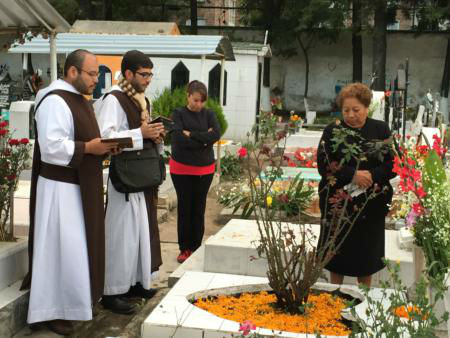Cremation resisted as answer to overcrowding at Mexico City cemeteries
MEXICO CITY (CNS) -- Amid graves adorned with marigolds in the San Isidro cemetery, brothers of the Missionaries of Christ the Priest offered prayers for visiting families remembering their recently deceased relatives.
Families flocked to graveyards for the observance of All Saints Day and Day of the Dead, celebrated Nov. 2, and built altars in their homes -- adorned with items their loved ones liked, ranging from plates of food to shots of tequila -- believing their relatives return to visit them that night.
But the graveyard tradition is gradually being threatened in Mexico City, mainly because cemetery space is becoming scarce and the local government is promoting cremation as an alternative. The effort does not sit well with some, including Catholics, who prefer burials.
"It's done for practical reasons," Deacon Benito Eadaein, a member of the Missionaries of Christ the Priest, said of the trend toward cremations.
"There is a tradition that comes with the church of there being a burial."
An inability to bury the dead causes some conflict for Catholics, especially because the church previously prohibited cremation. Church leaders in Mexico City have come around the idea of cremation, though, mainly for pragmatic reasons -- including the shortage of spaces in cemeteries and the problem of poor people being able to pay for burial plots in far-flung parts of the metropolitan area.
"Many members of the church accept cremation as something natural," says Bernardo Barranco, an academic and commentator on church matters in Mexico.
"It much prefers burials," he said of church leadership, "but it is increasingly flexible towards cremation."
A 1963 Vatican instruction, "Piam et Constantem" ("Devout and Constant"), and subsequent clarifications, permitted Catholics to be buried in non-Catholic cemeteries and to be cremated, if cremation was not chosen as a denial of church teaching. The church retains a preference for burial over cremation and directs cremated remains to be buried or inurned at a cemetery.
Part of the problem in Mexico City comes from massive growth and its mushrooming to a metropolitan area of 21 million people in more than 50 municipalities. Some cemeteries in the city are centuries old, but were originally on the outskirts when opened, explained Father Jose de Jesus Aguilar, pastor of the San Cosme Parish in the central San Rafael neighborhood.
Cost is causing many Catholics to carry out cremations if they cannot afford a crypt even in a church or private place.
"Many people, especially those of modest means ... are keeping the ashes of their family members in their homes," Father Aguilar said.
"There's a problem: one thing is that graveyards no longer exist, another thing is that they're now very far away. Another problem is that there are not a sufficient number of crypts," he added.
Mexico City approved a law in June allowing families to rent burial space for seven years, after which the rights for the plot would revert to the city. Bodies would be removed as needed and the space rented to others.
Of the 118 public cemeteries in the city, 31 percent are filled, according to the newspaper El Universal. Just five of the 14 private cemeteries have space remaining.
The changes have caused conflict for some groups in the more traditional communities of Mexico City's southern boroughs and many people expressed discomfort with the idea of cremation.
"It's the tradition to bury your loved ones," said Maricela Cuevas, a taco stand waitress in Mexico City, who planned to spend the evening of Nov. 2 at her relatives' graves.
"You only burn a body when there's an illness that might be contagious," said Clarisa Sister Maria Anguiano, who sold baked goods at the San Isidro cemetery.
"Burials are much better."
Day of the Dead dates to pre-Columbian times in Mexico and includes both indigenous and Catholic traditions such as the crosses of flower petals formed in front of altars.
Even with Halloween invading the country and kids going trick-or-treating on Oct. 31, church officials say the Day of the Dead has remained relevant in Mexico and has been embraced by non-Mexicans.
Promotion of the cultural part -- even the secular Mexican City government enables the construction of altars outside the Metropolitan Cathedral -- has caused people to embrace the religious part of Day of the Dead, Father Aguilar said.
"This cultural part makes it so that the religious part much more supported," he said.
"In (my) parish, normally 100 people come to pray for the deceased. On Nov. 2, there are 2,000 people (or more) making requests for their deceased loved ones."



















